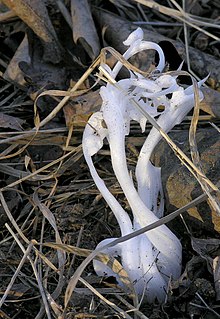Contents |
Formation
The formation of frost flowers, also known as "ice flowers," is dependent on a freezing weather condition occurring when the ground is not already frozen. The sap in the stem of the plants will expand (water expands when frozen), causing long, thin cracks to form along the length of the stem. Water is then drawn through these cracks via capillary action and freezes upon contact with the air. As more water is drawn through the cracks it pushes the thin ice layers further from the stem, causing a thin "petal" to form. In the case of woody plants and (living or dead) tree branches the freezing water is squeezed through the pores of the plant forming long thin strings of ice that look uncannily like hair i.e. "frost beard".The petals of frost flowers are very delicate and will break when touched. They usually melt or sublimate when exposed to sunlight and are usually visible in the early morning or in shaded areas.
Examples of plants that often form frost flowers are white crownbeard (Verbesina virginica), commonly called frostweed, yellow ironweed (Verbesina alternifolia), and Helianthemum canadense. They have also been observed growing from fallen branches of conifers and contain enough hydraulic power to strip the bark off.
Names
Frost flower formations are also referred to as "ice flowers", "ice blossoms", "frost castles", "frost beard", "ice castles", "ice ribbons" or "crystallofolia".A related phenomenon is needle ice that is extruded from soil.





No comments:
Post a Comment